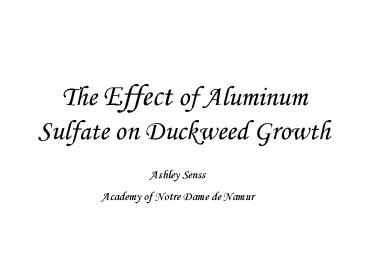The Effect of Aluminum Sulfate on Duckweed Growth - PowerPoint PPT Presentation
1 / 12
Title:
The Effect of Aluminum Sulfate on Duckweed Growth
Description:
Question and Purpose. How do various concentrations of. aluminum sulfate affect the growth of ... All the concentrations- .05M, .025M, .0125M, and .00625M ... – PowerPoint PPT presentation
Number of Views:560
Avg rating:3.0/5.0
Title: The Effect of Aluminum Sulfate on Duckweed Growth
1
The Effect of Aluminum Sulfate on Duckweed Growth
Ashley Senss Academy of Notre Dame de Namur
2
Question and Purpose
- How do various concentrations of
- aluminum sulfate affect the growth of
- duckweed?
- The purpose of this experiment was to
- study the effect of aluminum sulfate on
- duckweed (Lemna minor).
3
Background Information
- Aluminum Sulfate, Al2(SO4)3, is a white
crystalline compound used mainly in papermaking,
sanitation, and water purification. - Aluminum sulfate can also be harmful because it
mixes with water to form sulfuric acid.
- Duckweed is a small, aquatic, high-protein plant
that floats on the surface of ponds, wetlands,
and nutrient-rich lakes. - It reproduces through budding new fronds grow
from buds on the parent plant. - The growth of duckweed can be exceptionally
rapid.
4
Hypothesis
- If a high concentration of aluminum sulfate
- is added to a duckweed plant, then the
- duckweed plant will be unable to grow.
5
Procedure
- Measure out 33.3g of Al2 (SO4)3.
- Add 33.3g of Al2 (SO4)3 to a 1L flask.
- Pour spring water into the container until the 1L
mark is reached. (Solution 1) - Pour 500.0mL of Solution 1 into a 1L Erlenmeyer
flask. Add 500.0mL spring water. (Solution 2) - Pour 500.0mL of Solution 2 into a 1L flask. Add
500.0mL spring water. (Solution 3) - Pour 500.0mL of Solution 3 into a 1L Erlenmeyer
flask. Add 500.0mL spring water. (Solution 4) - Measure out 6mL of Solution 1.
- Add to each quadrant of two divided Petri dishes.
Label dishes Solution 1. - Repeat steps 7 and 8 for Solution 2, Solution 3,
Solution 4, and spring water. - Using forceps transfer 10 duckweed fronds to each
Petri dish. - Place each Petri dish under a fluorescent lamp.
- Observe each Petri dish each day for seven days.
- Count the number of fronds in each Petri dish
everyday. Record.
6
This graph represents the total number of living
duckweed fronds on Day 1 and Day 7 of the
experiment. This graph shows that there is a
significant drop in the number of living duckweed
fronds in each of the solutions. Also, there is
a significant increase in the number of living
duckweed in the control.
7
This graph shows the effect of adding various
concentrations of aluminum sulfate to duckweed on
duckweed growth. Notice that in every case in
which aluminum sulfate is added to duckweed, the
number of living duckweed severely decreases.
Also, notice that in the control, where no
aluminum sulfate is added, there is a significant
increase in the number of living duckweed. This
suggests that aluminum sulfate has an effect on
the growth of duckweed plants.
8
Results of T-test Application
Notice that after applying the T-test, there was
a significant difference between the Control and
each solution. Also, notice that there was no
significant difference between the Al2(SO4)3
solutions when compared to each other.
9
Percent Change of Living Duckweed from Day 1 to
Day 7
When the percent of change of living duckweed
from Day 1 to Day 7 was calculated for each
solution and the control, there was a significant
difference between the control and each of the
aluminum sulfate solutions, but no difference
among the variable solutions.
10
Variables
- the evaporation and condensation of water
- the changing of temperature in the lab over the
seven days
11
Conclusion
- All the concentrations- .05M, .025M, .0125M, and
.00625M- affected the duckweed in the same way.
Each of the solutions killed the duckweed after
seven days. - The results of this experiment suggest that the
chemicals leached out by aluminum cans that are
not recycled may harm living things such as
plants. This information can help provide basis
for how important recycling is in life. - Different metals other than aluminum sulfate
should be tested with the duckweed to further
study the effect of metals leached out into water
on plants such as duckweed. - According to the results, the hypothesis was
partially accepted because the duckweed plant in
the high concentrations of aluminum sulfate was
unable to grow. The idea was that the duckweed
plant in the low concentrations of aluminum
sulfate would have some growth, but instead the
low concentrations had the same effect on the
duckweed plant as the high concentrations.
12
References
- Bioassays. (2005). Why duckweed? Retrieved
November 10, 2005, from Environmental Inquiry
Web site - http//ei.cornell.edu/toxicology/bioassays/Duckw
eed/default.asp - Environmental Inquiry. (2005). Duckweed Bioassay
Method. Retrieved November 14, 2005, from
http//ei.cornell.edu/toxicology/bioassays/Duckwe
ed/ - method.asp
- Environmental Inquiry. (2005). Duckweed
Bioassays Compounds andConcentrations Retrieved
November 13, 2005, from http//ei.cornell.edu/t
oxicology/bioassays/duckweed/concentrati on.asp - The t test. (n.d.). Retrieved January 27, 2006,
from http//www.usip.edu/biology/bs130/statistics
20for20biology- t20test.html































